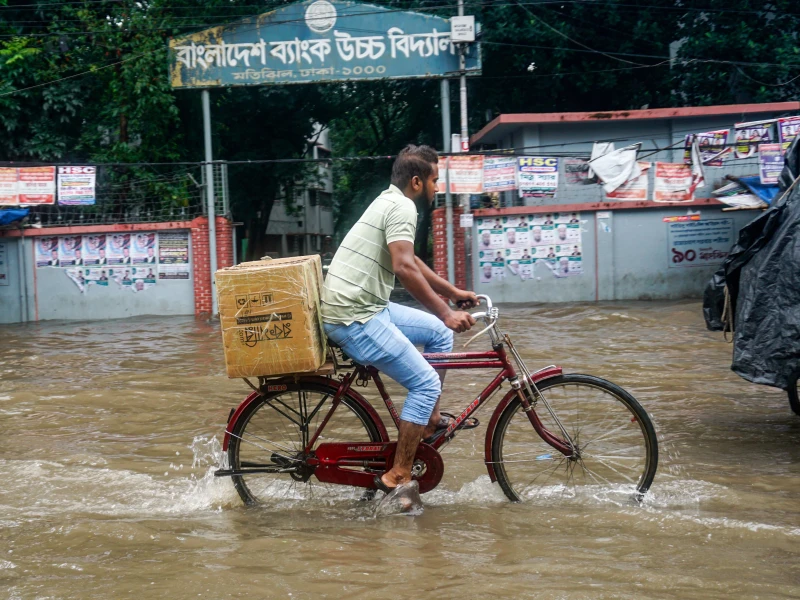A brief but heavy downpour early Monday once again laid bare Dhaka’s chronic waterlogging crisis, flooding streets, paralysing traffic, and even claiming a life despite an unexpected silver lining of dramatically improved air quality.
From Dhanmondi to Jigatola, commuters waded through ankle- to knee-deep water with umbrellas in hand as 40 mm of rainfall, recorded over the past 24 hours, submerged major roads and lanes across the capital. The Bangladesh Meteorological Department (BMD) reported that the rain began around 6 am and lasted an hour, inundating areas including Mohammadpur, Kalabagan, Karwan Bazar, Green Road, Manipuri Para, New Market, Mouchak, Malibagh, Asad Gate and Old Dhaka’s Najira Bazar.
A Met Office bulletin, valid for six hours from 7 am, said skies might remain cloudy and daytime temperatures could drop slightly.
The BMD also warned of more rain, with a low-pressure area forming over the North Bay and adjoining regions, and another system likely to intensify on September 24. Khulna, Barishal and Chattogram divisions are expected to see moderate to heavy showers, while Dhaka and several other divisions may receive light to moderate rainfall with gusty winds.
Electrocution Turns Rain Tragedy
The morning deluge turned deadly near Najira Bazar intersection, where Md Amin, a 30-year-old shop employee from Pirojpur’s Bhandaria upazila, was electrocuted while riding his bicycle through waterlogged streets.
Witnesses said he lost consciousness after touching electrified floodwater. Locals used a bamboo pole to pull him to safety and rushed him to Dhaka Medical College Hospital, but doctors declared him dead on arrival. Police have reported the incident to Bangshal station, and Amin’s body remains at the morgue.
Air Quality Sees Rare ‘Good’ Rating
Despite the misery, residents found solace in unusually clean air. At 9:15 am, Dhaka registered an Air Quality Index (AQI) of just 22 — firmly in the “good” category (0–50). Typically plagued by hazardous winter smog, the city’s air improves during the monsoon.
Globally, however, pollution remained acute: Lahore topped Monday’s list of most polluted cities with an AQI of 168, followed by Kolkata at 163 and Jakarta at 140. AQI levels between 150 and 200 are deemed “unhealthy,” while readings above 300 are “hazardous.” Bangladesh’s AQI tracks particulate matter (PM10 and PM2.5), NO₂, CO, SO₂ and ozone.
Urban Chaos Behind Chronic Floods
Experts and civic activists have long warned that Dhaka’s waterlogging is rooted in unregulated urbanisation and reckless development. Storm-water drainage systems suffer from illegal encroachment, landfill, diversions and blockages, obstructing natural flows.
The consequences — social, physical, economic and environmental — escalate during monsoons, underscoring the urgency for strong government intervention. Mismanagement, lack of coordination among agencies, slow maintenance, and careless littering aggravate the crisis, while negligence by city-corporation staff deepens public suffering.
Specialists say sustainable drainage and better inter-agency collaboration are crucial to shield utilities and urban life from monsoon havoc. Without an integrated approach, Dhaka’s residents remain at the mercy of each spell of rain, their relief over cleaner air quickly drowned by floodwaters.


 Prev Post :
Prev Post :
